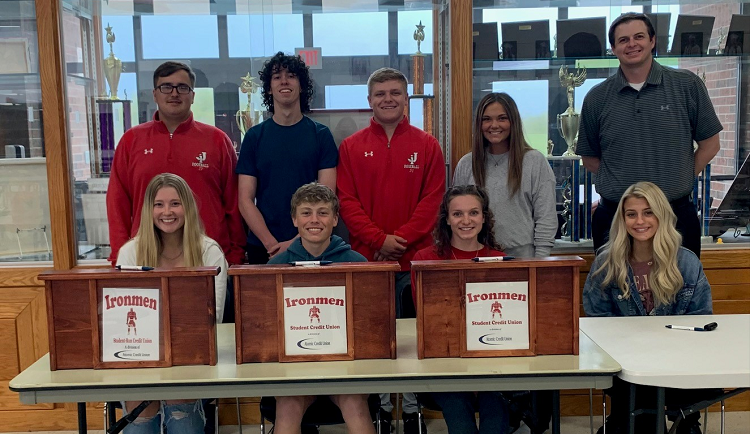Top-Level Takeaways
- Atomic Credit Union operates 58 student-run school branches.
- Graduated student-run branch members account for approximately 5% of total membership and 12% of digital transactions.
- The credit union’s average member age is 42 but aims to reduce that to 35.
Growing new business among young adults is imperative for any financial institution. Credit unions are no exception, and one Ohio cooperative might have found the secret to connecting with consumers before they reach their peak savings and borrowing years.
The average age of a credit union member in the United States is 47. At Atomic Credit Union ($532.5M, Piketon, OH), it’s 42, and the cooperative aims to reduce it to 35 within the next three years.
That’s a lot to ask of an institution with more than 62,000 members, but this southern Ohio FI is already making significant strides in that direction by leveraging the relationships it builds through its 58 student-run branches scattered across 19 mostly rural counties.
Atomic targets the young with no fee/double dividend savings accounts, checking accounts, ATM cards for children 10 and older, and debit cards for children 13 and older. Mobile apps and online banking also are part of the package.
Those student branches tend to be near the credit union’s growing network of full-service branches that are either new or renovated and designed to be attractive, welcoming destinations for members accustomed to or dependent on in-person banking in these often-low-income communities.
We hope Atomic’s program will impact our student members for the rest of their lives. As their financial needs evolve, Atomic will be at the forefront of their minds because of the relationships built at such an early age.
Transactional Accounts Are Key
Atomic has more than 10,000 youth members, says president and CEO Tom Griffiths. Those 58 student-run branches are home to approximately 5,900 of those accounts, with deposits totaling around $3.1 million and transactions exceeding 100,000 a month.

“Transactions” is the key word here, especially when it comes to transactional accounts.
“That’s where the rubber meets the road,” Griffiths says. “The progression of these accounts from saving money to conducting transactions gives these youth members real-world experience within the confines of a monitored, fee-free system. Gaining financial knowledge with the help of our staff becomes increasingly important as they enter adulthood and their financial needs evolve.”
Of course, the hope is that this evolution means a sticky relationship with Atomic Credit Union, and the numbers show the potential of this strategy — which includes financial education and counseling from kindergarten through high school — is not just academic.
Former student-run branch members who are now young adults comprise only 4.8% of Atomic’s membership but conduct nearly 9% of the cooperative’s debit card transactions and 11.65% of all digital transactions.
“These debit card transactions have tripled in the past three years,” Griffiths says. “During this same time period, loans have quadrupled for this segment of members.”
Want to learn more about Atomic’s student branch strategy? Read “School Branches Earn High Grades” on CreditUnions.com.
Multiple Channels For Building Lasting Ties
The credit union uses digital and physical channels for marketing student-run programs and youth accounts. The latter has its own webpage, and marketing materials throughout the regular branches promote Atomic’s youth programs.
“The members love to see the banners in the lobbies of the local community schools,” Griffiths says. “We’re ensuring there is no disconnect between the branch offices and the student-run facilities.”
The credit union also uses social media channels as well as yearbook advertisements, email marketing campaigns, and newspaper advertisements to promote youth accounts.
“Our student-run program is the only one of its kind in our area,” Griffiths says. “We’re causing young members to take notice of the benefits of credit union membership.”
Of course, youth programs are just the beginning of the benefits of credit union membership.
“We hope Atomic’s program will impact our student members for the rest of their lives,” the CEO adds. “As their financial needs evolve, Atomic will be at the forefront of their minds because of the relationships built at such an early age.”
3 Tips To Build Long-Lasting Relationships
Tom Griffiths, president and CEO of Atomic Credit Union, shares insight into attracting and retaining young members.
- Invest in technology. Youth members want the option to conduct their banking digitally.
- Market where they’re looking. Atomic Credit Union markets its accounts on Facebook, Instagram, and Twitter.
- Think “community.” Most of Atomic’s student-run branches coincide geographically with its robust community branch network.
Starting With Savings
Starting them out young with their own accounts is a long-term investment in the future of the member and the credit union, and it begins with the most basic of credit union offerings: the share account.
“The entire basis of Atomic’s student-run program is that each youth member has their own account,” Griffiths says. “Like most credit unions, that starts with a savings account. Our youth members learn financial skills by making deposits and tracking balances through our digital and branch channels. They experience the importance of depositing, withdrawing, and earning interest.”
Students earn rewards for making consistent deposits, helping to build enthusiasm year after year, Griffiths says, which is a reward of its own for the credit union.
The Opportunity To Be First
“Assisting youth members with their transactions provides the opportunity to build strong relationships,” Griffiths says. “Atomic has the unique opportunity to be the first financial institution to teach them savings skills.”
Then comes borrowing.

“When youth members arrive at the branch to conduct their transactions, the importance of saving and credit are emphasized as they meet with our experienced lending staff. The branch staff educates the youth members on how to manage their finances and begin their journey toward starting their credit,” the long-time Atomic CEO says. “This is extremely helpful once they graduate high school and either begin their college careers or venture out to begin their professional careers.”
Griffiths says the student-run program is an extension of its member-first mission to provide innovative products and services across those 19 counties it serves.
“Engaging our youth members on a weekly basis at 58 student-run branches is a long-term investment coinciding with the vision of becoming a premier financial service provider,” he says.
Ultimately, the credit union doesn’t sit on the sidelines and wait for young members to come knocking on the door. That’s what the student-run branches are all about.
“We used to rely on parents and guardians to open youth accounts for their loved ones,” Griffiths adds. “But by being in the area schools, we reach busy parents and guardians that might not have finances for their children at top-of-mind.”
How To Lead With Purpose
Why does your credit union exist? Do you serve your members and community in ways that set you apart from other financial choices? Rethink your role and responsibility to members, employees, communities, and the environment with Sustainable Business Strategy, a learning experience Callahan & Associates offers in collaboration with Harvard Business School Online.
